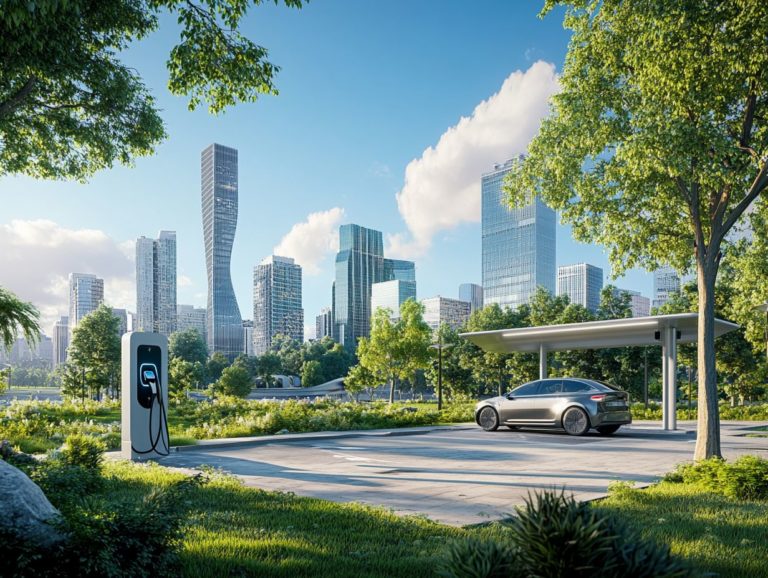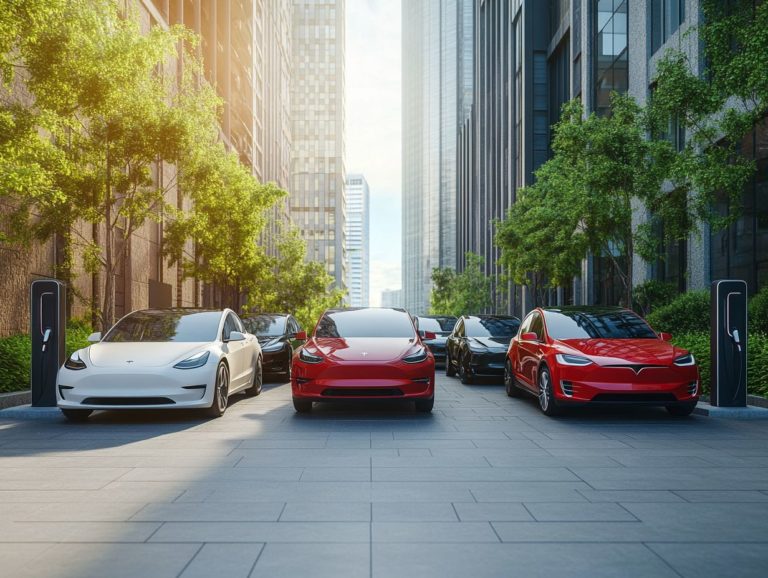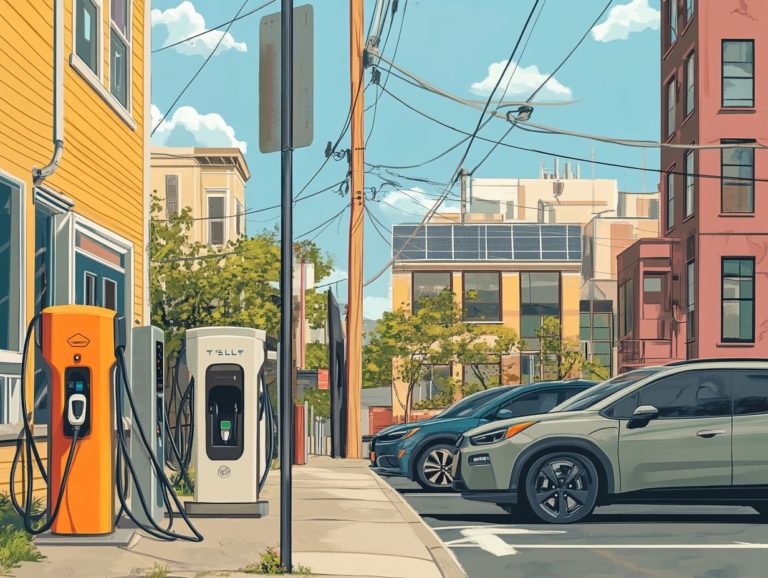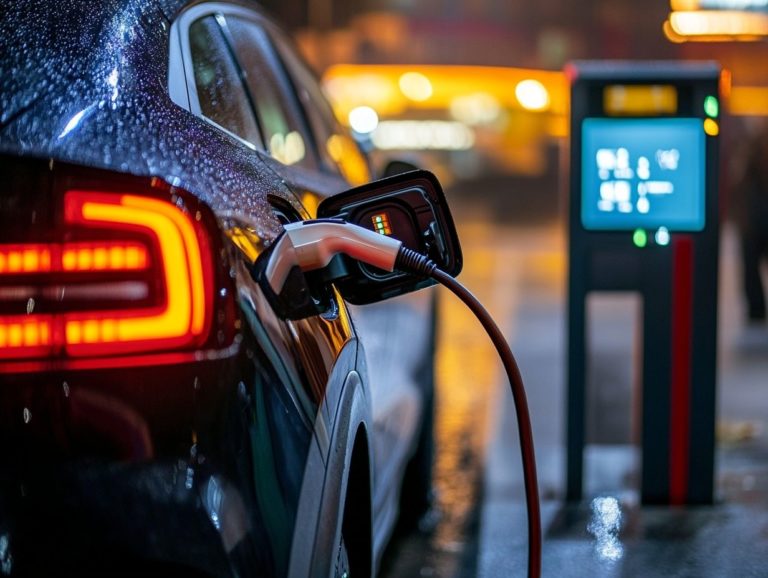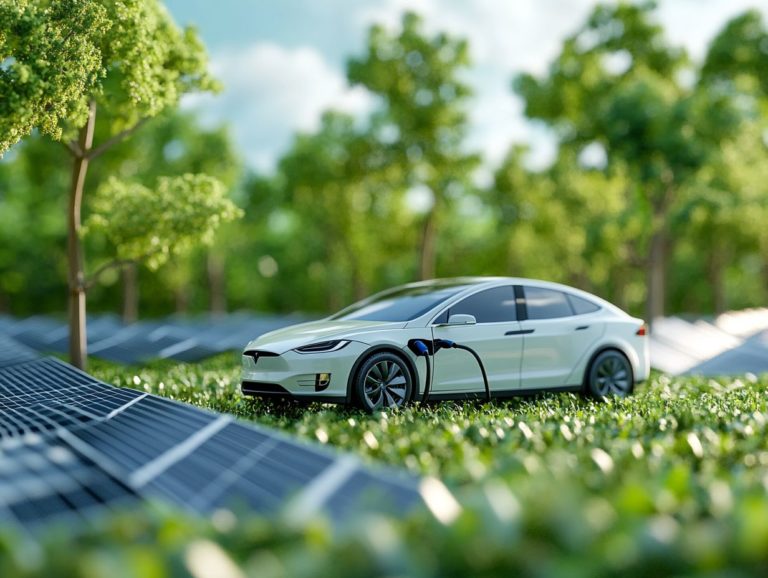Can I Charge an EV at Home?
Electric vehicles (EVs) are revolutionizing your approach to transportation, presenting an eco-friendly alternative to conventional gas-powered cars.
Thinking about going electric? Discover how easy it is to charge your EV at home!
Let’s explore how EVs work, the home charging options available to you, and the benefits of charging at home.
We will also address crucial factors to consider, such as electricity rates and environmental impact, before exploring alternatives like public charging stations.
Whether you re new to the EV world or seeking ways to enhance your charging experience, this guide is a treasure trove of valuable insights!
Contents
Key Takeaways:
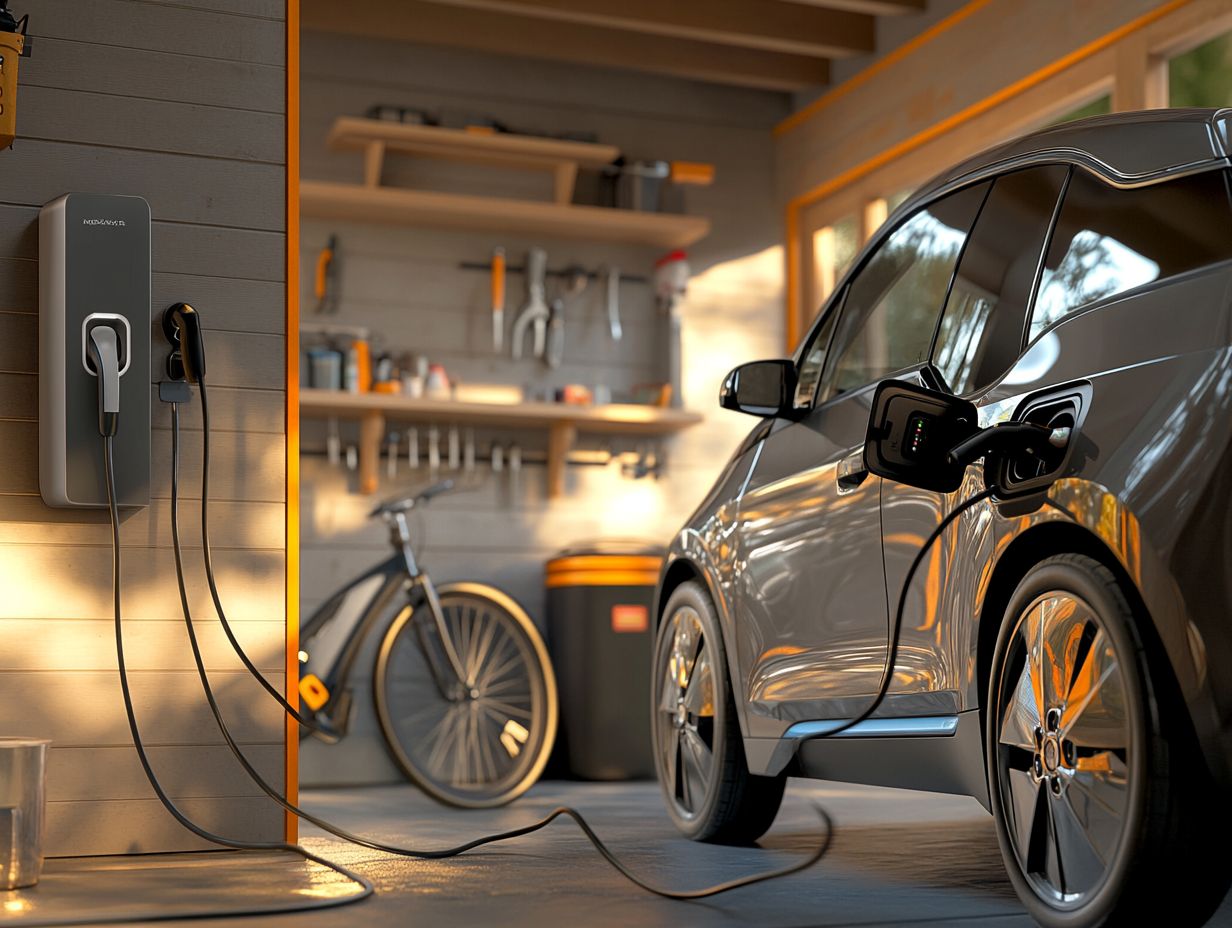
- Charging an EV at home is convenient and cost-effective, with various options available for installation based on individual needs and budget.
- Before deciding to charge an EV at home, it is important to consider factors such as electricity rates, environmental impact, and availability of public charging stations.
- Alternative options to home charging, such as using public charging stations, are available for EV owners who may not have access to home charging options.
Overview of Electric Vehicles (EVs)
Electric Vehicles (EVs) signify a groundbreaking transformation in transportation, leveraging cutting-edge technology to provide a cleaner, more sustainable alternative to conventional gasoline-powered cars. These electric vehicles run on electric motors fueled by batteries, which not only makes them highly efficient but also significantly better for the environment.
The surge in EV adoption is fueled by growing concerns about greenhouse gas emissions and escalating fuel prices. EVs are now more accessible with diverse charging infrastructure options ranging from home charging setups to convenient public stations making them practical for daily use.
Integrating renewable energy sources makes EVs an even more sustainable transportation option.
What are EVs and How Do They Work?
Electric Vehicles (EVs) are designed to operate using electric motors powered by rechargeable batteries, rather than the traditional internal combustion engines that rely on gasoline or diesel. You ll encounter various types of charging equipment, including Level 1 chargers, Level 2 chargers, and DC Fast Chargers, all aimed at replenishing your vehicle’s battery.
These electric motors efficiently convert electrical energy into mechanical energy, allowing your vehicle to glide smoothly and quietly down the road. The batteries store this energy and can be recharged through methods tailored to your needs and the available infrastructure. For example, Level 1 charging, which utilizes a standard household outlet, is typically slower and perfect for overnight charging at home. In contrast, Level 2 charging offers a quicker solution and is commonly found at public charging stations. If you’re on a long road trip, you’ll likely appreciate DC Fast Charging, which provides rapid replenishment of battery power.
During this entire charging process, the equipment that helps charge your EV safely and efficiently is called Electric Vehicle Supply Equipment (EVSE), which plays a vital role in ensuring safe and efficient energy transfer between the power source and your vehicle.
Charging an EV at Home
Charging your Electric Vehicle (EV) at home offers a seamless solution, allowing you to charge your electric vehicle overnight without relying on public charging stations.
Your home charging setup can incorporate various types of equipment, from Level 1 chargers that conveniently plug into standard outlets to Level 2 chargers requiring dedicated circuits for quicker charging speeds. A well-executed home installation can greatly improve both your charging experience and efficiency.
Types of Home Charging Options
As an Electric Vehicle (EV) owner, you have two primary home charging options: Level 1 and Level 2 chargers. Each offers distinct charging speeds and levels of convenience. Level 1 chargers use a standard 120-volt outlet, making them perfect for overnight charging. On the other hand, Level 2 chargers tap into a 240-volt outlet, providing faster charging options for quicker top-ups.
With Level 1 chargers, you can expect to gain about 4-5 miles of range per hour. This makes them a convenient choice for anyone who enjoys the luxury of overnight charging during their daily commute. In contrast, Level 2 chargers can deliver between 10 to 60 miles of range per hour, significantly cutting down your waiting time for a full charge. However, these chargers do require special installation, which may involve setting up a dedicated electrical circuit. This is a separate line for electricity that ensures your charger works efficiently, affecting your upfront costs, which vary widely based on installation complexity and the specific model you choose.
If you re looking for something innovative and eco-friendly, consider a solar home charger. This option allows you to harness renewable energy, seamlessly integrating with your existing home energy systems. Not only could this help reduce your electricity bills, but it also minimizes your carbon footprint, aligning with a more sustainable lifestyle.
Installation Requirements and Costs

Installing a charging station at your home involves careful consideration of several key factors. You ll want to evaluate the charging capacity of your chosen charger alongside your home s electrical system.
Depending on your situation, you may need to upgrade your electrical panel or install a dedicated circuit for Level 2 chargers, leading to varying costs based on local regulations and your existing electrical setup.
Plus, assessing the price differences between various charging models is essential. Level 1 chargers are generally more affordable but come with slower charging times. On the other hand, while Level 2 chargers might carry a higher price tag, they offer a much more efficient charging experience.
It’s also wise to explore installation services. While hiring a professional may add to your expenses, it can ensure safety and compliance with local building codes. Consider options like the Economic 7 tariff for off-peak charging. This can result in significant savings on your electricity bills, making the investment in home charging not only practical but also financially advantageous in the long run.
Benefits of Home Charging
Home charging provides a wealth of advantages for Electric Vehicle (EV) owners. You ll enjoy unmatched convenience and great savings on fueling costs while having the freedom to recharge whenever you choose, without depending on public charging stations.
With a dedicated charging setup, you can effortlessly charge your vehicle overnight, ensuring that you start each day with a full battery. This eliminates the stress of searching for charging facilities while you’re out and about.
Convenience and Cost Savings
The convenience of home charging truly cannot be overstated. As an Electric Vehicle (EV) owner, you have the luxury of recharging your vehicle overnight, ensuring you wake up to a fully charged battery, ready to tackle the day ahead. This saves you time and translates into significant cost savings over the long haul compared to relying on public charging or traditional fueling methods.
By eliminating the need to make regular trips to gas stations, you can seamlessly integrate charging into your nightly routine, transforming what was once a chore into a simple habit. The speed of home charging is another crucial factor in your decision-making process. With faster charging solutions at your disposal, you can rest assured that your vehicle will be primed and ready in the morning, even after a long day of driving.
For instance, a Level 2 home charger can replenish your battery in just a few hours, allowing you to plan short trips or daily commutes without the nagging worry of dwindling charge levels. This gives you the power to save money while enhancing your daily life with the confidence of convenient, accessible energy whenever you need it.
Considerations Before Charging an EV at Home
Before you decide to charge your Electric Vehicle (EV) at home, it’s essential to consider several key factors. Take a closer look at local electricity rates, check what charging options are available, and assess the benefits of home EV charging solutions to understand the potential environmental impact of your charging methods.
By understanding these elements, you ll be better equipped to make informed decisions about the most suitable charging solutions tailored to your unique circumstances.
Electricity Rates and Availability
Electricity rates play a vital role in shaping the cost-effectiveness of charging your Electric Vehicle (EV) at home. Options like the Economic 7 tariff offer the advantage of reduced rates during off-peak hours, significantly cutting down your charging expenses.
Understanding the availability of local power supply is essential for optimizing your charging strategy.
These rates can vary significantly depending on your utility provider and location. This creates a diverse landscape of fixed versus variable rate structures.
Fixed rates provide a sense of stability, enabling you to predict your expenses with confidence. Meanwhile, variable rates can fluctuate based on demand and overall grid usage. By analyzing these patterns, you can time your charging sessions to align with periods of lower demand, maximizing your savings.
Many also opt for smart chargers that can be programmed to start charging when rates dip. This transforms what was once seen as a costly investment into a more economical mode of transportation, enhancing both your wallet and your driving experience.
Environmental Impact
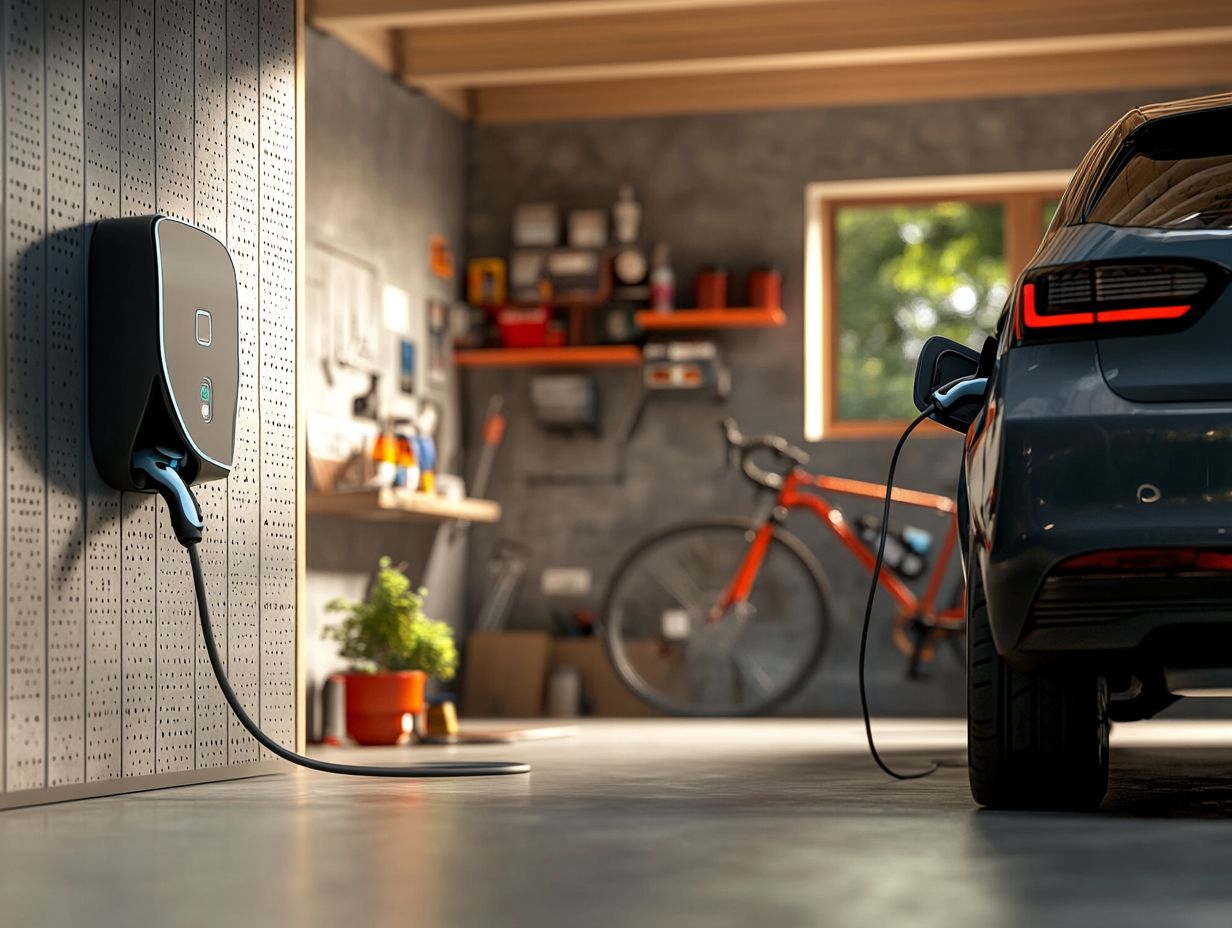
The environmental impact of charging an Electric Vehicle (EV) at home is crucial to consider, especially when the charging infrastructure predominantly relies on fossil fuels. By choosing renewable energy sources for your home charging, you can significantly reduce the carbon footprint associated with your EV!
Integrating renewable energy systems like solar panels boosts your energy independence while diminishing greenhouse gas emissions on a larger scale. Switching to cleaner energy is not just smart; it s essential for a sustainable future!
As electric vehicle adoption continues to rise, now is the time to embrace a robust, green charging infrastructure! Stakeholders in the energy sector are recognizing that supporting and expanding sustainable practices can vastly improve the efficiency and environmental integrity of owning an electric vehicle.
Alternatives to Home Charging
Home charging might be the go-to option for many Electric Vehicle (EV) owners, but it’s worth exploring the array of alternatives that cater to diverse needs.
Public charging stations, workplace charging, and the ever-expanding charging networks can significantly enhance your EV experience. These options offer added convenience, especially if you find yourself without access to a suitable home charging setup.
Public Charging Stations and Other Options
Public charging stations are an essential resource for Electric Vehicle (EV) owners, offering convenient charging options in well-chosen locations like shopping centers, public parking lots, and major roadways. This charging infrastructure is crucial for long road trips and supports the increasing demand for EVs in urban areas!
By establishing a comprehensive network of these stations, cities and charging providers make it easier for you to charge your vehicle while running errands or enjoying a meal out.
You ll find a range of chargers available, from standard Level 2 units (which charge your EV faster than ordinary outlets) to high-speed DC fast chargers, catering to your specific needs and influencing your charging habits.
When you see charging facilities within your community, it sends a clear message about a commitment to sustainability. This encourages you and others to consider transitioning from traditional vehicles. Ultimately, these public charging options work seamlessly alongside home charging setups, creating a robust ecosystem that plays a pivotal role in accelerating EV adoption and boosting confidence among those who may still be on the fence!
Frequently Asked Questions
Can I Charge an EV at Home?
Absolutely! You can charge your EV right at home, provided you have an electrical outlet and the right charging equipment. If you’re wondering, can I use a regular outlet to charge my EV?
What Equipment Do I Need?

You will need a Level 1 or Level 2 EV charging station. For more information on how to proceed, check out installing a home EV charger. You can buy and install one at home or use the charging cable that comes with your EV.
What s the Difference Between Level 1 and Level 2 Charging Stations?
Level 1 charging uses a standard 120-volt outlet. It adds about 4-5 miles of range per hour.
Level 2 charging uses a 240-volt outlet and adds around 25-30 miles of range per hour. Choose based on your needs!
Do I Need to Hire a Professional for Installation?
Hiring a licensed electrician is best for installing a Level 2 charging station. If you re experienced with electrical work, you might handle it yourself.
How Much Does It Cost to Charge an EV at Home?
The cost varies based on your electricity rates and your EV’s battery size. Usually, it s about $0.10-$0.20 per kilowatt-hour.
Is It Safe to Charge an EV at Home?
Yes, it s safe as long as you follow safety guidelines and use approved equipment. Have a professional inspect your electrical system before installation.

